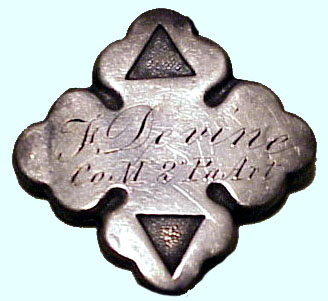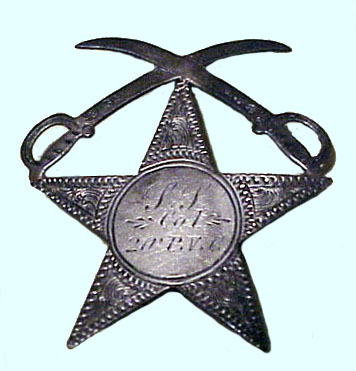Engraved Badges

| 
|
| Eighteenth Army Corps Badge Courtesy Jay Graybeal | Department of West Virginia Badge Courtesy Jay Graybeal |

| 
|
| Eighteenth Army Corps Badge Courtesy Jay Graybeal | Department of West Virginia Badge Courtesy Jay Graybeal |
Corps badges made out of colored cloth were issued to soldiers and typically worn on top of kepis. In addition to these many soldiers privately purchased higher quality badges, which were often worn over the left breast pocket. These were often engraved with the soldier's name and regiment and doubled as identification.
These additional privately purchased badges were not officially approved but contributed to moral and generally soldiers wore them without any problem. However, Private Alfred Bellard of the 1st Regiment Veteran Reserve Corps, who was serving as part of the garrison of Washington, D.C., related an incident in which an officer objected and made him remove a shield shaped badge that a photograph shows he wore over his left breast.
"We were now under strict military rule not being allowed to wear anything that was not issued by the government, even to our shoes. When out on pass, we must have our jackets buttoned up to our chin, waist belt on and also white gloves. Our major, who was an officer of the regular army, had but one eye, tried to make himself very conspicuous. While I was walking along Penn. Ave. one day out on pass I had my corps badge and shield on my jacket, and that was unbuttoned, when who should come along but the major, who ordered me to take off my badges and button my jacket. I did neither, only while I was in his site."
Gone for a Soldier: The Civil War Memoirs of Private Alfred Bellard Edited by David Donald
The first badge is that of the Eighteenth Army Corps engraved with the name of F. Devine of the 2nd Pennsylvania Heavy Artillery. This badge was adopted on June 7, 1864 by authority of a circular issued by corps commander Major General William F. Smith. The style of the badge is a cross botonée or cross with trifoliate sides. The issued badges were cloth in the familiar red, white and blue colors for the first, second and third divisions of the corps, but a sterling silver engraved badge such as this was not in a division color.
The badge belonged to Sergeant Franklin Devine. He originally served with the Company A, 132nd Pennsylvania Infantry Regiment which was a nine-month regiment. Despite being a nine-month unit the 132nd was involved in three major battles and took heavy combat casualties. However, it is best remembered as the unit that was attacked by a swarm of bees during the battle of Antietam. Following this service he joined the Company M, 2nd Pennsylvania Heavy Artillery Regiment. He was shot in the mouth in front of Petersburg in the summer of 1864, while serving in the Eighteenth Army Corps. Like many of the "Heavies" the 2nd was moved out of the defenses of Washington and placed in the field army by General Grant.The star badge with crossed sabers may be more generic. An advertisement by B. T. Hayward of 208 Broadway, New York depicts the identical badge made of coin silver. This particular badge belonged to Corporal Samuel Stinson, Company I, 20th Pennsylvania Volunteer Cavalry. This unit was formed in February 1864 as a three-year regiment and assigned to the first cavalry division of the Department of West Virginia.
A five-pointed star was adopted as an insignia by general orders of the Third Division, Department of West Virginia on March 23, 1864. It should be noted that the same device was in use by the Twelfth Army Corps, but they were serving in a different theater. This may have led to the Department of West Virginia adopting a different badge depicting a spread eagle on January 3, 1865. Several examples of surviving badges similar to the above are for units that were not part of the Department of West Virginia. It is possible that this badge saw a more generic use as a cavalry badge and was not limited to the Department of West Virginia.
These badges exist in nearly endless variations and were jeweler made in small numbers. They have been faked and are also subject to confusion with badges made for veterans after the war. The book Echos of Glory: Arms and Equipment of the Union has a nice group of them pictured on pages 172 and 173. In addition Stanley Phillip's Civil War Corps Badges and Other Related Awards, Badges, Medals of the Period is a serious reference on the topic.